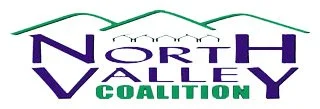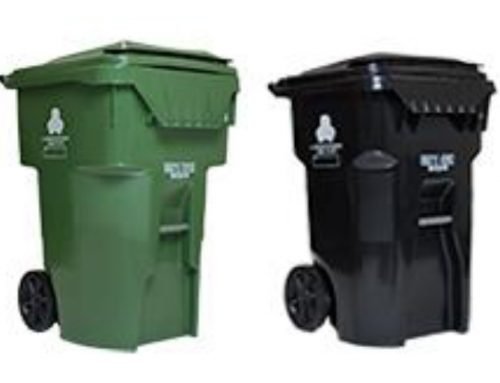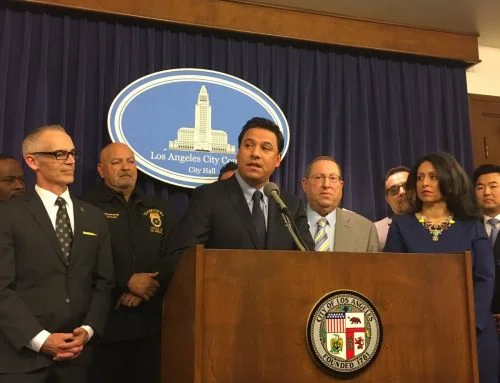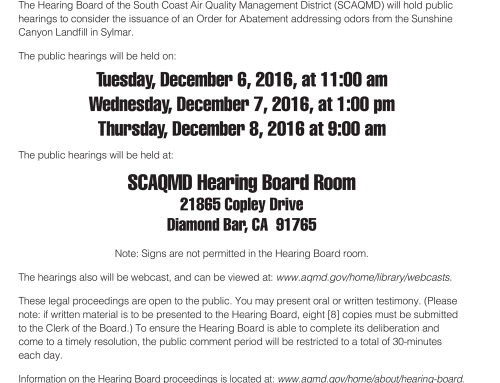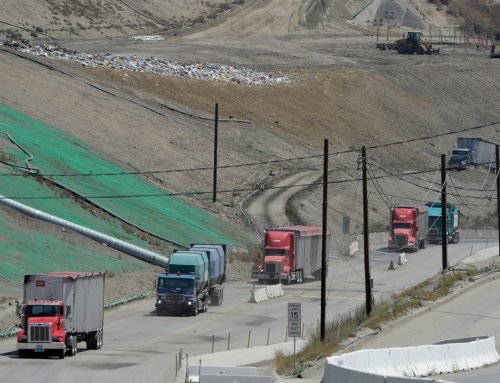https://angeles2.sierraclub.org/sunshine_canyon_garbage_dump_and_waterair_safety
Timeline for Sunshine Canyon Landfill
Both the L.A. City & County owned land in Sunshine Canyon
1991 Old City Dump was closed.
1996 County expansion opened in 1996
1999 City passed the expansion & reopening of the Sunshine Canyon Landfill on the city side. It actually opened in 2005
2009 the County and City landfill were combined
Information from Wayde Hunter, president of the North Valley Coalition & the website below:
Granada Hills is a section of L.A. that is near the Sunshine Canyon Landfill and they feel they have done more than their share of housing L.A. City’s garbage. There are Granada Hills’ houses whose next door neighbor is the dump. They feel other parts of the city should take responsibility for waste, also. The old City dump was here, in one form or another, for thirty-five years and the City promised “valuable recreational land” on the site when it closed in 1991. The County expansion, which opened in 1996, was further away from the community. On 12/08/99, our L.A. City Council passed their expansion, and the reopening of the Sunshine Canyon Landfill on the City side, despite the danger to the air, water, families, and natural resources of all of Los Angeles! This was done despite alternatives such as rail haul to other remote sites, and better recycling programs. The approvals also included the provision to combine the County side landfill and to provide additional space to the tune of 90,000,000 tons. The landfill was combined into one landfill in 2009, which has made it the largest dump in the USA. With the City expansion opening in 2005 and the combining of the City and County sides in 2009 the bulk of the operations are now much nearer to neighborhoods. The dump is operating in the lowest part of a very deep canyon, a mile away from the entrance. Impacts will increase as operations move higher and when more methane gas is generated by the waste pile. As was mentioned, it would be much fairer if each district could come up with a plan for disposing of its own waste. The landfills would be smaller than one great huge landfill and the pollution would be more manageable.
Air Quality & Other Toxics With the combining of the City and County landfills the daily operations have moved ever closer to homes and the neighbors are now experiencing more and more odor complaints from residents. In 2011 the number of reported odor problems caused by Sunshine Canyon Landfill was 10 times worse than all of the other 15 landfills “combined” within the South Coast Air Quality Management District’s (SCAQMD) oversight. In fact 20% of all the calls to the SCAQMD for any reason that year were from Granada Hills about the landfill. Damaging landfill gas, such as methane, is released from decomposing waste in the landfill; to stop this gas from being released into the atmosphere flares are used to burn the gas. At least 351 tons per day of emissions are released from the three existing flares not counting any surface emissions. A fourth flare is under construction with a fifth flare starting the permitting process. There will be at least 2,600 truck trips per day, delivering trash to the dump. The North Valley Coalition was able to get the County Supervisors to agree that Sunshine would not take any garbage that was not produced in LA County. Most of the trash will come from the City of Los Angeles, but much of the trash will come from many other cities in Los Angeles County that have been collected by past owner BFI and the dump’s new owners.”
The air impacts, which cannot be mitigated, causes health problems such as cancer, birth defects, lung damage, immune system damage, and nerve damage. This is due to the relationship between air toxic pollutants (known or suspected) generated by diesel emissions from trucks, the outgassing of methane at the surface of the landfill, as well as particulate emissions of PM2 and PM1O caused by the flaring of the methane. The most impacted by these toxics are the young, pregnant women, and the elderly. A landfill such as Sunshine Canyon can be expected to generate 20,000,000 to 40,000,000 cubic feet of methane gas a day as it fills. Plans and permits have been approved for a Gas-to-Energy plant to be constructed and operational in the next two years. Unfortunately for the neighbors, this plant which will generate electricity from the methane gas diverted from some of the flares will produce more PM2 and PM10 than the existing flares. The dump will continue to receive up to 66.000 tons of commercial, industrial, and household wastes each week, including sewer products and contaminated soil. It is estimated that over 300 tons of this weekly inflow will be toxic or hazardous. There is no way to mitigate the degradation of the air quality — this is according to the previous owner BFI’s own experts, the Los Angeles Unified School District, the AQMD, and other agencies. Children are in danger, according to the Board of Education City of Los Angeles, the Los Angeles Unified School District, the South Coast Air Quality Management District, and some members of the Los Angeles City Council.
Earthquake issues The dump site is in a seismic-hazard area, within an Alquist-Priolo Study Zone (Seismic and Earth Movement) located next to the Santa Susana fault line, in a geologically unstable area. There will be continued movement potentially causing tears in the dump liner system and compromising its leachate collection system. Leachate is water that is in contact with decomposing solid waste, the percolating water becomes contaminated and if it then flows out of the waste material it is termed leachate. Several earthquakes have been recorded within the dump most notably in 1971 & 1994. Landslides are a common occurrence. The landfill operators themselves have caused several massive landslides internally over the years which have resulted in the abandonment of the Countyside leachate treatment plant, weight scales, and access road.
There were safer places for the dump. At the hearing for the City’s 5-year trash disposal contract, several competitors of BFI came in with estimates that were less than BFI to haul the trash away to areas that would not be impacted by the refuse or the particulate and diesel emissions. This would cost (by the City’s own admission at that time) 50 cents per person per month in Los Angeles City. Remember that these were high estimates and that the City was refusing to ask for bids! The City wanted this dump for revenue purposes and franchise fees it would generate. The City was the responsible agency for investigating the validity and the safety of the SEIR (Subsequent Environmental Impact Report). The City abdicated this responsibility to consultants hired by BFI, and have never verified the results!
The City tore out nearly 1000 oak trees alone, and destroyed streams and acres of wetlands in order to put in this dump, as well as ruining the habitat for many species of wildlife. The partial total of the destruction so far when combined with the Countyside of the landfill amounts to over 6000 mature oaks, 20,000 other trees including black walnut, and spruce, and 12 acres of wetland.
Landfill
We have just discussed the water that has been imported from far-away places into the L.A. area. This imported water flows through the general area in the picture above, and in the picture below where there are many other water treatment facilities located together in the middle of the picture.
In the picture above which looks northwest it is obvious that there is a large freeway section of the I-5 between the I-14 and 210 Interchanges (to the right), and the biggest landfill in the USA, the Sunshine Canyon Landfill (to the left of the freeway and in the fore ground). What you can’t see in this picture is that the main water treatment plant for this imported water is nearby and to the southeast. This facility purifies the water and then sends it to the uncovered L.A. Reservoir for storage until it is used for drinking water at your house. (See picture of reservoir & dump below.) This is a poorly planned and unhealthy situation; we need to have the imported water very far away from this gigantic garbage landfill—not practically next door as it is now. To make matters worse this is a high earthquake area.
Note: Editor Elaine took a tour of the Los Angeles Aqueduct Filtration Plant
There is a legal requirement to cover all reservoirs but the L.A. Reservoir is too big to have a constructed roof on top of its waters. Instead, they are already in the process of covering the complete water surface with black plastic balls. As of 7-26-13 the reservoir was about 1/3 to maybe ½ covered with the black balls.
Expansion
This picture of LA Reservoir & Sunshine Dump was taken at an earlier date but the
situation is still the same
With this latest expansion, the Sunshine Canyon Landfill is the largest dump in the United States, only hundreds of feet from the largest water supplier in the United States (LA Dept. of Water & Power (LADWP) & Metropolitan Water District), providing water for 19,000,000 people living in Los Angeles and surrounding counties. This is next to the totally open and exposed LADWP reservoir which holds our treated drinking water! The landfill is within 500 feet of an already earthquake damaged tunnel that carries the LADWP’s water from the California Aqueduct to its water treatment plant, and potentially contaminated waters exiting the landfill discharges to the County Flood Control channel which passes directly over it.
Winds in the area have been clocked in excess of 100 miles an hour; these winds carry pathogens from the dump into our water supply. Toxic, chemical and human wastes can potentially contaminate birds that wander through the trash looking for food. The birds then go back to the open reservoir to drink and rest in the water, and yes, defecate into the same water that comes out of your faucet. This dump is slowly polluting the groundwater through unlined sections of the old City landfill, and potentially any leakage from under the County landfill whose single liner system started leaking only six years after it was installed. In the 1999 City Council hearing when the dump was voted in, BFI admitted to problems in one of its test wells.
Aquaduct
This is a picture of the “Cascades” at Balboa Blvd. & San Fernando Road
The pipe down the side is actually making electricity.
Picture taken by Sierra Club member Gayle Dufour
There is a marker near these “Cascades” that reads: “The Los Angeles Aqueduct Cascade. California Historical Marker No. 653 Cascades – This is the terminus of the Los Angeles – Owens River Aqueduct, which brings water 338 miles from the eastern slopes of the Sierra Nevada to the City of Los Angeles.”
If you were to look at a map of the area near the Sunshine Landfill you would see that a variety of Los Angeles’ water purification and storage facilities are near the Sunshine Waste Landfill. This is very poor planning and an unhealthy situation. Below is a link to a photo of the area with explanations:
https://wikimapia.org/#lat=34.3763813&lon=-118.4011174&z=12&l=0&m=b
The photo map shows the following facilities close together from North to South. (Sunshine Canyon Landfill is furthest north & Lower Van Norman dam is the furthest south.) You will see the L.A. Reservoir in the middle of the picture. To see the other structure locations you will have to put your pointer on top of the white geometric shapes; then each name will appear.
Sunshine Canyon Landfill
Los Angeles Aqueduct Filtration Plant (MWD Jensen Filtration Plant)
Upper Van Norman Lake Basin
City of Los Angeles Water Treatment Plant
Los Angeles Reservoir
Los Angeles Dam
1971 Earthquake damage Lower Van Norman dam site
Lower Van Norman Dam
